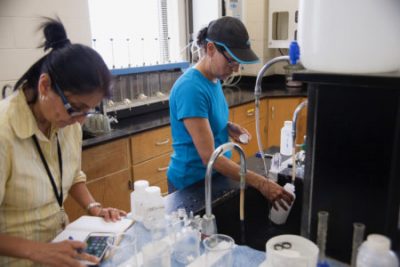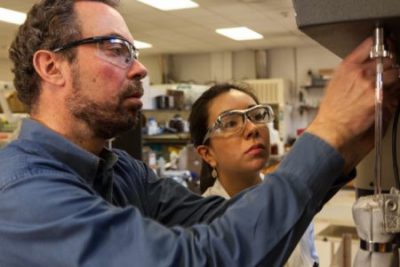Published in partnership with North Carolina Health News
Water filtration effectiveness, effects on human health, persistence in river sediments, and bioaccumulation in eastern oyster beds are among a new set of studies driven by public concern over GenX and the dearth of science surrounding it.
Supporter Spotlight

Scientists and regulators are mapping out how to monitor and ultimately deal with the current crisis and how to create regulation in a way that prevents another from recurring. This is occurring even as investigations continue and political debate heats up over the state’s response to revelations that GenX and other potentially harmful compounds have been dumped into the Cape Fear River for several decades.
During the past few weeks, researchers have outlined the complicated task of identifying “emerging compounds,” or recently discovered pollutants, and their risk to human health at industry conferences and community gatherings, legislative hearings and in presentations to environmental oversight panels.
Last week, members of the recently formed House Select Committee on River Quality met for the first time. That meeting was, in part, to get an update on plans by scientists from the University of North Carolina Wilmington and staff at the Cape Fear Public Utility Authority on how they intend to spend $435,000 for research authorized by the legislature last month in House Bill 56.
Gov. Roy Cooper vetoed the legislation last week, saying the bill’s GenX-related provisions fell short of what was needed and that the it did not include any of his request for emergency funding for state agencies and were focused only on the Wilmington area.
“The legislation passed by the General Assembly, House Bill 56, provides no resources to the state agencies charged with protecting drinking water and preventing illegal chemicals from being discharged into our rivers,” Cooper said in a statement released after his veto. “It gives the impression of action while allowing the long-term problem to fester. And it unnecessarily rolls back other environmental protections for landfills, river basins, and our beaches.”
Supporter Spotlight
But with a new session of the legislature scheduled to open Tuesday, General Assembly leaders could hold an override vote as early as this week.
Studies Planned
Despite the uncertainty over the fate of the legislation, both UNCW and utility authority officials say they will push ahead with research and monitoring regardless of what happens to the bill.
UNCW chemistry professor Ralph Mead told the committee the answers won’t come easy, especially when it comes to determining what else might be in the Cape Fear.

It’s not like a television crime show where a forensic investigator puts a sample in a machine and the answer appears on screen in an instant, he said. “In reality, the science takes time and takes a lot of effort.”
Mead said that studying how GenX breaks down in the environment and determining how much GenX is sequestered in river sediments are important in filling the gaps in what’s known about the compound and its potential effects.
He said those gaps are helping fuel public concerns including the fear that GenX could have effects similar to those of other chemicals in the same class, such as C8, which research suggests has lifelong hormonal effects on animals and perhaps humans who are exposed in utero.
“I think what we’re seeing is the holes in the research,” Mead said in response to questions from the committee about the public’s perception of the risk. “People don’t have a good handle on the effects and impact of GenX. I think references are being made to the legacy compounds like C8 because that’s the best sort of information we have.”
In all, UNCW hopes to launch studies in the following five areas:
- Establishing a method for analysis of per- and polyfluoroalkyl substances in raw and treated drinking water.
- Analyzing levels of GenX in river sediments and their transport and potential for being remobilized in the water column. Plans are to take samples in seven estuary areas from Southport to Wilmington, as well as upstream and downstream of the Chemours facility.
- A yearlong study on biodegradation of GenX in sediments.
- Bioaccumulation studies in marine organisms focusing on the effects of exposure on oysters and the potential for effects on human health when those oysters are eaten.
- Biomagnification of contaminants as they move up the food chain, with study of economic effects, household filtration system effectiveness and how local water customers perceive the risks of using the water.
UNCW researchers are also working with the utility authority on its testing of the effectiveness of filtration methods. The researchers plan to test granular activated charcoal, reverse osmosis and nano-filtration as methods of eliminating the chemicals.
Both are under tight deadlines set out in HB56, with interim reports on all studies due to the legislature’s Environmental Review Commission by Dec. 1.
Also in the works is a proposed expedited study through the National Institute of Environmental Health Sciences led by N.C. State epidemiologist Jane Hoppin.

Hoppin will be working with N.C. State professor Detlef Knappe, who helped lead the research that identified the presence of GenX and other compounds in the Cape Fear, and East Carolina University epidemiologist Jamie DeWitt. The group wants to study the levels of GenX in humans and its health effects.
Whether the state proceeds with what’s outlined in HB56, funds the governor’s request or both, the costs involved are just the tip of the iceberg.
CFPUA estimates that depending on the type of treatment chosen, the upfront cost of adding more sophisticated filtration systems to remove GenX and other complex compounds from its drinking water could run from $1.7 million for improved carbon filtration to $113 million for a reverse-osmosis and nano-filtration system.
Monitoring costs are likely to rise as well, starting with additional equipment purchases to speed testing turnaround times. Knappe told the North Carolina Environmental Management Commission’s Water Quality Committee last month that the state will likely need more labs capable of conducting research using high resolution mass spectrometry.
“I think in this day and age when we’re dealing with a much larger universe of chemicals, it’s important that labs get equipped with this kind of instrumentation so we can confidently identify and quantify what is in our drinking water,” Knappe said.







